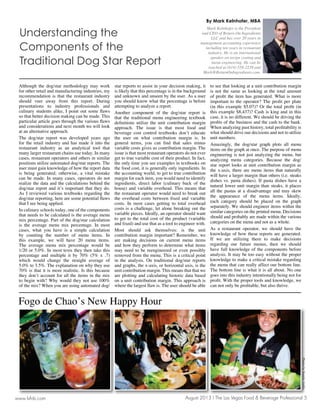
Understanding the Components of the Traditional Dog Star Report
- 1. August 2013 I The Las Vegas Food & Beverage Professional 5www.lvfnb.com Although the dog/star methodology may work for other retail and manufacturing industries, my recommendation is that the restaurant industry presentations to industry professionals and so that better decision making can be made. This and considerations and next month we will look at an alternative approach. The dog/star report was developed years ago for the retail industry and has made it into the restaurant industry as an analytical tool that many larger restaurant chains use today. In many cases, restaurant operators and others in similar user must gain knowledge of how the report data is being generated; otherwise, a vital mistake can be made. In many cases, operators do not dog/star report and it’s important that they do. As I reviewed various textbooks regarding the that I see being applied. In culinary schools today, one of the components that needs to be calculated is the average menu mix percentage. Part of the dog/star calculation is the average menu mix percentage. In most cases, what you have is a simple calculation by counting the number of menu items. In this example, we will have 20 menu items. The average menu mix percentage would be 1/20 or 5.0%. In most texts they then take this percentage and multiple it by 70% (5% x .7) which would change the straight average of 5.0% to 3.5%. The explanation on why they use 70% is that it is more realistic. Is this because they don’t account for all the items in the mix to begin with? Why would they not use 100% of the mix? When you are using automated dog/ star reports to assist in your decision making, it is likely that this percentage is in the background and unknown and unseen by the user. As a user you should know what the percentage is before Another component of the dog/star report is that the traditional menu engineering textbook approach. The issue is that most food and beverage cost control textbooks don’t educate the user on what contribution margin is. In variable costs gives us contribution margin. The issue is that most restaurant operators do not ever get to true variable cost of their product. In fact, the only time you see examples in textbooks on the food cost, it is generally only ingredients. In the accounting world, to get to true contribution margin for each item, you would need to identify ingredients, direct labor (culinary back of the house) and variable overhead. This means that the restaurant operator would need to break out costs. In most cases getting to total overhead costs is a challenge, let alone breaking out the variable pieces. Ideally, an operator should want to get to the total cost of the product (variable Most should ask themselves: is the unit contribution margin important? Remember, we are making decisions on current menu items and how they perform to determine what items may need to be reengineered or even possibly removed from the menu. This is a critical point in the analysis. On traditional dog/star reports unit contribution margin. This means that that we are plotting and calculating historic data based on a unit contribution margin. This approach is to see that looking at a unit contribution margin is not the same as looking at the total amount this example $8,437)? Cash is king and in this case, it is no different. We should be driving the unit numbers. items on the graph at once. The purpose of menu star report looks at unit contribution margin as the x-axis, there are menu items that naturally will have a larger margin than others (i.e. steaks dishes vs. pasta dishes). If pasta dishes have a natural lower unit margin than steaks, it places all the pastas at a disadvantage and may skew the appearance of the menu items. Ideally, each category should be placed on the graph separately. We should engineer items within the should and probably are made within the various categories on the menu and not as a whole. As a restaurant operator, we should have the knowledge of how these reports are generated. regarding our future menus, then we should have full knowledge of the components before analysis. It may be too easy without the proper knowledge to make a critical mistake regarding the menu that can really affect our bottom line. The bottom line is what it is all about. No one goes into this industry intentionally being not for Understanding the Components of the Traditional Dog Star Report By Mark Kelnhofer, MBA Mark Kelnhofer is the President and CEO of Return On Ingredients LLC and has over 20 years in management accounting experience including ten years in restaurant industry. He is an international speaker on recipe costing and menu engineering. He can be reached at (614) 558-2239 and Mark@ReturnOnIngredients.com. PhotosbyJuanitaAiello Fogo de Chao’s New Happy Hour PhotosbyJuanitaAiello
